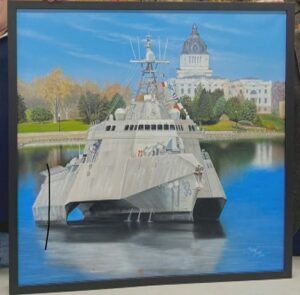Sailors that will be stationed aboard a United States Navy ship named after South Dakota’s capital city are visiting their ship’s namesake this week.
During the visit, Sailors assigned to the USS Pierre will have the opportunity to learn about the city and history of Pierre. Sailors will meet with the USS Pierre Commissioning Committee, receive a tour from Mayor Steve Harding, speak at local elementary schools, volunteer with Feeding South Dakota and enjoy a social event onboard pontoons on the Missouri River.
Master Chief David Hyatt is the command master chief of Littoral Combat Ship Squadron One. That’s the squadron the USS Pierre will join when it completes its sea trials. He says namesake visits are an opportunity for Sailors to begin building a lasting relationship with the community their ship is named after. Hyatt says the Sailors on the USS Pierre are an example of the caliber of Sailors that are serving aboard the ships that protect the United States.

The USS Pierre is an Independence-variant littoral combat ship, homeported in San Diego. It’s currently undergoing sea trials, which take about one year to complete. Providing she completes them successfully, the Commissioning– or when the ship officially goes on active duty– is scheduled for 2025. The USS Pierre’s Keel Laying, or the official start of the shipbuilding process, happened last summer in Alabama.
Earlier this year, representatives from Austal USA also spent some time in Pierre getting some insight regarding the place the ship is named for. Austal is the company that built the ship.
The USS Pierre is 419 feet long and capable of operating at speeds of more than 46mph, or 40 knots. It’s a highly maneuverable, lethal and adaptable ship, designed to support focused mine countermeasures, anti-submarine warfare and surface warfare missions.
Littoral combat ships are fast, optimally-manned, mission-tailored surface combatants that operate in near-shore and open-ocean environments, winning against 21st-century threats. LCS integrate with joint, combined, manned and unmanned teams to support forward-presence, maritime security, sea control, and deterrence missions around the globe.
